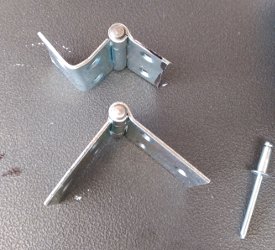- Category: Travel
- Written by Paul Chubb
- Hits: 677
Building a standards based gas locker

One thing that most if not all caravans and camper vans need is somewhere to store gas bottles. According to the Australian standard, which in turn flows into the state laws and regulations, you are not allowed to carry gas bottles in a caravan or camper van without a standards based housing. This article describes the journey to achieving such a housing in Tin Lizzy.
There are two basic approaches to carrying gas bottles in a caravan: you can put them outside in an approved holder – it has to secure the bottle through 4g of force – or in an external cupboard at the back or the front.
In camper vans the options are limited to an externally opening cupboard. The most noticeable examples are cupboards that are inserted through the side of the van with a vented door on the outside. The standard says that the cupboard must only be able to be opened from the outside. There is a less well known solution of having a cupboard with its door butting up against one of the van doors. I was not aware of this interpretation of the standard until a friendly Sprinter owner showed me his professionally installed layout that had a gas cupboard under a bench seat at the back of his van. The door couldn’t be opened unless the back van door was opened thus meeting the standard’s requirement of not being able to be opened from the interior. It is this approach that I took. I didn’t want to cut a hole in the side of Tin Lizzy in case I weakened the structure. I felt I just didn’t know enough.
Besides needing a cupboard you are only allowed to carry a small amount of gas. The top limit seems to be two 9kg bottles. This, from my reading, varies slightly from state to state I wanted to build my cupboard under the bed at the back of the van. It was only high enough to take the c.4kg cylinders anyway and so I would be well within the limits if I carried two cylinders.
While there are both sheet steel and fibre glass inserts available for the type of cupboard built through the side of a van, there is no head start for the type of cupboard I was building. Another big issue is that there is no standard set of dimensions for any bottle size. In the end I created a table showing the dimensions of all the gas cupboard inserts I could find for a 4kg bottle. Considering this table, I decided on dimensions that covered the most common sizes of gas cupboard insert.
The standard says that you need to build the cupboard out of moisture resistant materials. I was thinking ‘Ok maybe some melamine would do.’ I checked with the ACT regulator and they said no – aluminium was their suggestion, I used sheet steel – see below.
I was happy to also find out, that I didn’t need to get gas certification. The cut off point is if there are pipes installed into the cupboard to carry gas through the van – reticulation is the technical term. Since my cupboard just stored the bottles, and didn’t have any attachments, I didn’t need certification. However the regulator was very keen that I still meet the standards – something I planned to do anyway. The standards are based on an acceptable level of risk. I didn’t have the knowledge to fully understand the risks so I was going to follow the standards religiously. Also, if I ever decide to get a plumber to reticulate the gas and and certify my setup, hopefully, it will just be a case of running the pipes.
It is actually quite difficult to find a gas certifier to certify van installations. You need a house style gas fitter – usually also a plumber – not an auto gas fitter. I talked to my friendly plumber and he refused. The issue is that such plumbers are very familiar with the standards for house gas. They know nothing about the standards for caravans and camper vans which are detailed in a different part of the same standards document. I also rang the local caravan and camper van repairer and builder. They also couldn’t suggest a suitable plumber. Overall the additional utility that adding the piping I would like – a socket outside the van – wasn’t worth the effort of first finding a certifier and then paying for it.
The cupboard must be gas vapour tight to the inside of the van. At the same time it requires a 25mm diameter or larger vapour drain in the bottom of the cupboard. As cylinders heat up they shed vapour through an over pressure relief valve. If the cylinder leaks, the gas will drop out of the van using this drain. This helps to ensure that there is not sufficient gas in the air to light or explode.
The outlet of the drain needs to be certain distances away from van openings and also heat or spark sources. The regulator was very helpful with this and it turned out that as long as the end of the drain was under the van, pointed away from the exhaust and the direction of travel it would be fine. The minimum distance to the exhaust was 500mm which was easily achieved.
The Build
I wanted to start with something around the right size and shape. I could have purchased some galvanised flat steel and bent it however I didn’t have a pan brake to do the bending, so any corners would be rough.
Living in Canberra, second hand office equipment is plentiful and cheap. I had a thought, and realised that a filing cabinet is almost the right cross section. $40 later I owned a nice powder coated four draw cabinet. The powder coating meant that it would be very resistant to corrosion – another requirement from the standard.

I cut the top off the cabinet giving me a box with two open sides that was just too large in one dimension. I then cut the box again and slid the edges together, bringing that dimension down to the size I wanted. This join was well sealed with the expensive silicone I had chosen. The silicone was especially formulated for making and repairing gaskets – just what I was doing.
The end side that was open was covered with another sheet of steel from the filing cabinet. It was where the front of the cabinet was, so I had a nice rim to seal and connect to. The ideal fastener for sheet steel is pot or pop rivets – both terms are widely used. I used lots of small ones to fasten these pieces of sheet metal.
As well as sealing the joints that I made, I ran silicone around all the joints that were already in the filing cabinet. This left me with a box with one large side open that should be gas tight on the other walls.
To be gas tight, the door needed to fit over the front with an overlap allowing a gasket to seal the gas inside – you see these kind of doors on industrial ovens and fridge/freezers. For this to work I needed a solid rim around the door and also the door hole that was smooth. I built the frame of the door out of 15mm SHS (square hollow section – essentially square pipe 15mm on a side) as well as a frame for the front of the box. I did my best to make the door frame and door hole frame exactly the same size. This was going to be important to ensure a good seal. There would be an over lap of the door of around 15mm.

I took a piece of sheet steel and sealed it onto my front frame and used rivets to fasten it down. I then used an angle grinder to cut out the door hole. At Bunnings you can get really light metal angle. It is used to go in corners of gyprocked or dry walled houses. The nice thing is that it is as cheap as chips and ideal for the purpose I used it for. I cut lengths of it to trim around the door hole. This was riveted and stuck down with silicone. To keep the smooth surface, the rivets were not used on the face. The back side of the angle was bent around onto the back side of the frame and then riveted down. This whole front section, was then inserted into the box. Again I sealed it with silicone and used rivets to attach it in place.
I now had a nice smooth surface around my door hole to mount a gasket. A while back I bought some p section rubber strip from Clark rubber for another project. I had some left and so thought I would try it. I cut pieces of p section rubber with mitred corners to fit around the door. These I riveted down through the tail of the P, the tail facing into the door hole. Once these were in place, I formed the corners from my trusty silicone making a rectangular gasket. To finish it off and make it stand up and so improve sealing, I ran a bead of silicone around under the edge of my new gasket. The finished gasket looks quite professional.

The next step was to mount the door. Ideally, you would use some specially shaped hinges called cranked hinges. They essentially have the outside edge of one wing bent at right angles, allowing it to sit over the door. These would have to be sourced from the Internet so instead I bought hinges with the largest leaves I could find and bent my own. I realised that the door was reasonably heavy so I chose thick pot rivets. This was a bad choice. My pot rivet guns are cheapies because I rarely work with sheet metal. I have two. I bent the handles on the first gun trying to set these rivets. The second didn’t bend but I had to extend the arms of the gun with a piece of steel tube to set the rivets.
For the latch, I needed something that would pull the door down hard against the gasket. Bunnings sell three of these – called compression locks. I thought: “It is only 15mm I should be able to use the smallest.” I actually needed the largest to span the required distance. Once installed though, it worked well.
I completed the box by covering all the corners where I had made joins with strips of the gyprock angle I bought, again using plenty of silicone.
The box was complete, but was it gas vapour tight? This is essentially a very low bar. When finished, the box will be open via the 25mm drain to the outside so the pressure of the vapor will be minimal. To check though, I did a real smoke test. I lit a small fire in the box and then looked for escaping smoke. No smoke escaped and so I pronounced the box vapour proof.
Now it was time to install the box. I was annoyed with myself, although I had decided where to put the box, I hadn’t looked underneath the van. I, by preference, would have put the drain in the middle of the box. However the van had both the spare tyre and also the fuel tank in that location. The drain had to go into the back left corner of the box.
To make the drain I purchased a cheap waste/drain assembly for a bath or sink. It was about 50mm diameter. The nice thing about this approach is that it is all standard cheap parts. You add the correct diameter plastic pipe and a 45 degree angle and you are done. This is all stuck together with the standard pipe glue.
The only challenging thing is to drill the two holes for the drain: one through the box and one through the base of the van. You can use a standard hole saw to do this, however you will need an extremely beefy drill to power it. I burnt out my Makita drilling the box. For the van I drilled a series of holes in a circle and then joined them with a hacksaw blade.

Some thought then needs to go into designing the pipe. It needs to point away from the direction of travel – ie the front – and also any ignition sources – ie the exhaust. It needs to be 500mm from the exhaust and 1m from any opening in the van. This assumes that it doesn’t extend out from under the van, otherwise different measurements apply. I pointed the elbow at 45 degrees so that it pointed approximately at the left rear corner. This was my take on pointing away from the direction of travel and also the exhaust. The exhaust is on the right rear corner. It was far enough back to be over a metre from the tailgate and a metre from the nearest window.
The waste included a grate which was removed – the drain, according to the regulator, must be a smooth opening. There was a large flange on the waste which I stuck down with silicone. Final step was to screw down through the waste. Box and van floor, making a tight seal. The box itself, was built into the bed frame with various supports so it couldn’t move.
The final thing that the standard requires is that you put a sticker indicating where the gas is stored. The standard specifies this sticker in great detail. They are readily available in many places and I bought mine from ebay. Note be sure you get the Australian version as most countries have their own.

























